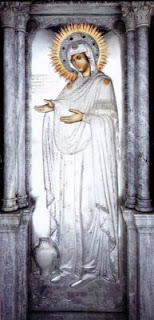The Holy and miraculous Icon of Panagia Gerontissa is
located at the Holy Monastery of Pantokratoros, Mount Athos and is the
Monastery’s most valued possession.
Tradition states that the Icon was donated to the
Monastery by the Roman (Byzantine) Emperor Alexios Komninos the 1st.
It is a copy of the mosaic Icon of Panagia which was located at the
Pantocratoros Monastery in Constantinople, which was built by the same emperor.
It is the only ancient Icon on Mount Athos that depicts
the Theotokos in full and in a prayer pose (Deisis).
The first miracle attributed to the Icon dates back to
the time of emperor Alexios Komninos the 1st, when he instructed
that the Monastery be built 500 metres from where it stands on a rise where the
current chapel of St. Athanasius of Alexandria stands.
During construction, every evening after the workers had
departed the building site, their tools and the Icon would disappear from the
current site and re-appear 500 metres away at the current site of the
Monastery. This happened many times until the emperor came to the realization
that the Icon of Panagia Gerontissa wanted the monastery in the location It was
showing. As a result, the Monastery was built in its current location.
The Holy Icon’s original position was in the sanctuary
behind the altar table. One day the Abbot of the Monastery who was very old,
ill and frail, realizing that his death was near, asked the presiding Priest
serving the liturgy, to speed up the Liturgy as he wanted to take Communion
before he passed away. The presiding Priest did not listen to the Abbots
request.
Then miraculously, Panagia, speaking through Her Holy
Icon, commanded the Priest to speed up the liturgy. The Priest, immediately obeyed, and shortly after the old
and frail Abbot took Holy Communion, he passed away. This is why the Holy Icon
was named Gerontissa, due to its relationship with the then Geronta (Abbot) of
the Monastery. The Hoy Icon of Panagia Gerontissa was then placed outside of
the sanctuary and on the left hand side marble pole of the main church, where
it remains to this day.
The Holy Icon was covered in an all silver oklad (cover)
with the donations of a noble woman of Constantinople.
The amphora (water jug) that appears carved on the
silver cover, was depicted in order to commemorate another miracle performed by
the Holy Icon in the 17th century. The Monastery was short of oil
for its daily use, and its monks decided to leave the Monastery in favour of
other Monasteries that had all they needed.
The Abbot of the time appealed to the monks to trust in
the providence of Panagia Gerontissa, and he prayed with all his heart for
Panagia to provide for her Monastery. Some days later, one of the remaining
monks saw oil coming out from under the door where the oil was kept. He opened
the door and seen that the large oil container was so full that the oil was
spilling from it onto the floor. From that time onwards and for the next 300
years, the monastery has never been out of oil.
Another miracle attributed to the Holy Icon of Panagia
Gerontissa dates back to the evening of December the 1st 1948, when
fire surrounded the Monastery, however the Monastery remained without any
damage.
The Holy Icon of Panagia Gerontissa was placed inside a
custom stand made of marble which was donated by the former Abbot of the
Monastery Theofilos of Limnos. In 1997, the Icon was removed from the marble
stand after 200 years under the supervision of the Archaeological institute.
After months of tests and carbon dating the Holy Icon was confirmed to be from
the 11th century, precisely in the reign of the Emperor Alexios
Komnenos the 1st.
The Icon in its current form was altered when the silver
oklad (cover, poukamison) was added in the 19th century. It was
crafted in St. Petersburg and is of priceless value. The face of Panagia and
Her hands were repainted in order to match with the new silver cover. The archaeologists
have discovered fragments of the original painting also.
Many miracles are attributed to the Holy Icon of
Panagia Gerontissa, which is clearly visible due to the amount of gifts that
have been left before the Icon.
Panagia’s face as depicted on the Holy Icon of Panagia
Gerontissa, has a sweet and merciful expression leaving every pilgrim with a
sense of happiness, hope and comfort.






























